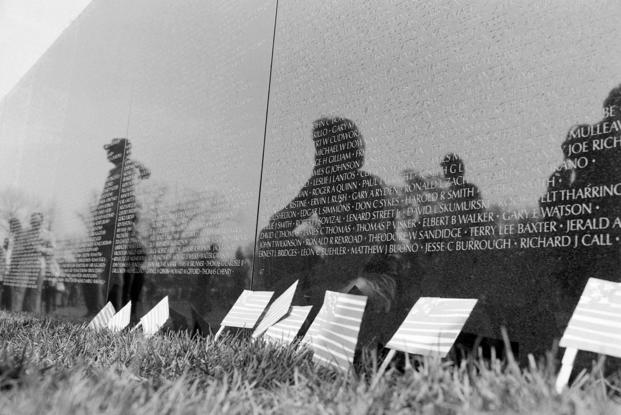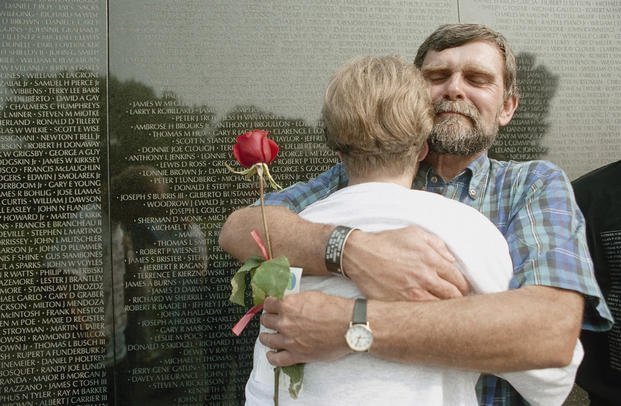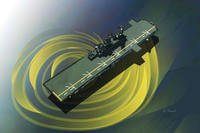President Ronald Reagan wasn't coming because of what the White House called "security concerns" and so it fell to a veteran who had been a prisoner of war for more than eight years to represent the administration at the dedication of the Vietnam Veterans Memorial on Nov. 11, 1982.
Retired Navy Cmdr. Everett Alvarez, the first U.S. aviator to be captured by the North Vietnamese when his A-4 Skyhawk was shot down in August 1964, took on the task of speaking at the dedication with some doubts about the memorial's design.
But his main concern was with how veterans, and the nation, would react to a shiny black granite wall dug into the earth that listed the names of more than 57,900 U.S. service members who lost their lives in a divisive conflict, a number that would grow over the years.
Read Next: 2022 Veterans Day Deals, Discounts and Freebies
"The Wall" has since become the most visited memorial in Washington and maintains its iconic grip on the national conscience. But back in 1982, "Oh yeah, I had concerns. It was a tumultuous time," the 84-year-old Alvarez recalled in a recent phone interview with Military.com.
In more normal times, the head of the Department of Veterans Affairs, known as the Veterans Administration back then, would have been the logical choice to represent the government at the memorial's dedication in the president's absence, but VA Administrator Bob Nimmo had resigned abruptly in October 1982 after enraging veterans with his comments and conduct in office.
He had called veterans organizations "greedy," and written off the aftereffects of Agent Orange as cases of "a little teenage acne."
Nimmo "had basically been run out of town," said Alvarez, who had been confirmed in July 1982 as deputy administrator, or No. 2, at the VA.
It was his job to go to the dedication despite his misgivings with the design by Maya Lin, a 21-year-old Yale undergraduate architecture student, whose concept was chosen in an arts competition.
"At the time, I had to deal with this trench. Initially, I thought it was unkind," Alvarez said of the memorial's black walls, which extended along a walkway and reached out to grasp at ground level.

The unconventional design broke with what many thought of as war memorial tradition -- white marble columns in a Greco-Roman motif, or maybe the great man on a horse.
"To me, it was representative of how veterans were being depicted in the media and Hollywood -- in other words, losers, drug addicts, homeless, living in the woods," Alvarez said, and that was not how he viewed Vietnam veterans.
"They gave their lives; they did their jobs," he said. "They were asked to go, and a lot of them got drafted, a lot of them volunteered. And they went and did their jobs, and it was basically to preserve freedom. You can argue one way or another whether it was successful."
Some of the commentaries from pundits and Vietnam veterans also were highly critical, suggesting that the memorial was a "monument to defeat," a "black gash of shame," or a "wailing wall for draft dodgers."
But all of that angst appeared to dissolve when veterans themselves and the parents, relatives and friends who had waited in vain for the return of those listed on the walls -- in chronological rather than alphabetical order, without ranks to distinguish the officers from the privates and lance corporals -- saw the monument.
At the ceremony on Nov. 11, 1982, the crowd surged forward at the conclusion of the remarks, taking down, with the help of the National Park Service, the snow fence that separated them from the walls. They reached out to touch, chiseled into the granite, the names of those they knew -- to speak to them, to leave behind a note, or maybe their jungle boots, or a pack of cigarettes, or a can of beer.
As he watched the emotional response, Alvarez said, "I changed my view" on the memorial as he "realized how it affected the public," and what it would mean to future generations.
"What struck me was the tremendous outpouring of the people, the veterans that came for the dedication and their families," he said. "That was heartwarming. It is, I would have to say, very therapeutic in a way for a lot of people."
'We Shouldn't Have Been Able to Do It'
Veterans who come to the memorial, located off Constitution Avenue NW near the Lincoln Memorial, for the first time can find the experience overwhelming.
"I felt like I had walked into a cathedral," former Army 1st Lt. Marsha Four, a nurse who served in Vietnam from 1969 to 1970, said of her first sight of the memorial in 1992. "At night, I came up over a rise and, all of a sudden, the wall comes up out of the earth. I literally fell down on my knees. It was so powerful to see the wall and all those names.
"It's simple, it's blunt and it's the truth," she said of the memorial. The message is that "this is what happened. This is the sacrifice we made."
Four, now 75, has been coming back to the site on the National Mall every year since 1992, and she'll be coming down from Philadelphia, where she's in a chapter of the Vietnam Veterans of America, for the 40th anniversary.
The Vietnam Veterans Memorial Fund, or VVMF, has planned a series of events for the anniversary, beginning with a reading of the more than 58,300 names now listed on the memorial's walls on Nov. 7 and concluding at midnight Nov. 10, followed by ceremonies and speakers at the memorial on Veterans Day, Nov. 11. (More info can be found at vvmf.org.)
Former Army Sgt. Grant Coates, who served with the 78th Combat Tracker Team from September 1968 to September 1969, will be coming to the anniversary from Oneonta, N.Y. He has been coming every year since 1986, when he visited with his mother, wife and daughter.
"Personally, it's a pilgrimage to me," Coates said. He looks at the names and wonders: "Each person would have had a life, would have had a future." Every time he visits, he searches out the name of a buddy, Spc. 4 Edwin Erlin Cox Jr., to say hello. Cox was killed by a booby trap that also wounded Coates.
The memorial's reflective walls also invite engagement from visitors, and that can be tough for some veterans, said former Navy Petty Officer 3rd Class John P. Brown of Youngstown, Ohio, who ran cargo and troop carrier craft around Danang and along the coast in support of the 3rd Marine Division.

"When you see yourself reflected in that wall, it hits hard," he said. "It's tough, but you've got to keep fighting on for yourself and your family. You can't let the war take over your life. You have to seek help when you need it. I got the help, and I continue to get the help," said Brown, a former national commander of the AMVETS organization.
Then there are the Vietnam veterans for whom it is still too painful to visit the memorial, even after 40 years. Former Marine Staff Sgt. Sheldon Hartsfield, who served with the 1st Battalion, 4th Marines, in Vietnam in 1968 and 1969, said that he eventually wanted to visit the memorial in Washington but did not think he was ready.
As a past Missouri state commander for AMVETS, he has visited the "Traveling Wall" version of the memorial when it comes to Missouri, and he continues to serve at funerals for veterans in the state. But "personally, it's difficult for me" to make the trip to Washington. "I'm here, I made it home," he said, but "I have not successfully defeated all my demons yet."
The wall's impact on veterans and how the memorial would be received by a nation still mired in endless debate over the war, how it was fought, and who was to blame for the chaotic withdrawal that saw Vietnamese clinging to the skids of departing helicopters, was an issue for the small and sometimes fractious group of veterans who advocated in the late 1970s for the project.
But the main concern was to get approval for a site on the National Mall and to set the politics aside. What the design would be and how they'd raise the $8 million that would eventually be needed to complete the memorial -- well, they'd figure it out.
"We were too dumb and too naïve to realize we shouldn't have been able to do it," said Robert Doubek, a former Air Force intelligence officer who would become executive director of the Vietnam Veterans Memorial Fund.
"We were just junior officers and enlisted," he said, "entrusted with two acres of the most valuable land in the country" on the National Mall when Congress and President Jimmy Carter gave approval for the site.
"The whole idea was Scruggs,'" Doubek said, referring to Jan Scruggs, who founded the VVMF and was the driving force behind the effort to create the memorial. Scruggs is an enlisted Army veteran who served in Vietnam in 1969 and received a Purple Heart for wounds from a rocket-propelled grenade.
At a 1979 White House Rose Garden ceremony where Carter signed the bill approving the site, Scruggs gave his vision for the meaning behind the memorial: "We do not seek to make any statement about the correctness of the war. Rather, by honoring those who sacrificed, we hope to provide a symbol of national unity and reconciliation," he said.
Shortly after the White House ceremony, the VVMF announced that there would be an open arts competition for the design and issued a booklet setting out parameters for what the artists should consider in submitting proposals.
The memorial should seek to inspire contemplation and reflection, the booklet said. "Finally, we wish to repeat that the Memorial is not to be a political statement, and that its purpose is to honor the service and memory of the war's dead, its missing, and its veterans -- not the war itself. The Memorial should be conciliatory, transcending the tragedy of the war."
In Doubek's estimation, the design by Maya Lin met and exceeded the expectations of the VVMF. "I would simply say it's had a profound effect on the soul of the country. It's a sacred place of healing, remembrance and homage for veterans, their families and all Americans," he said.
"It represents immense pain and sacrifice, and it's played a pivotal role in our country's cultural shift to separate the war from the warrior because nobody anymore puts down Vietnam veterans for the war," Doubek said.
For West Point English Professor Elizabeth Samet, whose books "No Man's Land" and "Looking For the Good War: American Amnesia and the Violent Pursuit of Happiness" have explored the interplay and influence of war and literature on the national memory, the Vietnam Veterans Memorial is a place apart from monuments to previous wars.
Speaking personally, and not as a representative of the Army or the U.S. Military Academy, Samet said, "The first time I went, I remember it remaining for me the most powerful war memorial I have ever visited.
"It seems to me that Maya Lin's wall does two things: It acknowledges the sacrifice of those who fought and honors that sacrifice," she said. "It's also a monument to the real horrors of war. It doesn't celebrate, it commemorates, and for that reason I think it seems to be starkly honest.
"The names are about memory. They're about commemoration, about not forgetting," Samet added. "Most memorials have to represent the many, but this monument by mentioning, by naming all those who died, gives an individual kind of honor that one normally doesn't think of as possible in a memorial. So it's quite extraordinary for that reason."
A Place to Let Go
In his remarks at the dedication of the memorial on the afternoon of Nov. 11, 1982, Alvarez said that "many Americans today still have a difficult time dealing with that war, but no one can debate the service and sacrifice of those who fell while serving."
He regretted that veterans returning from Vietnam did not receive "the type of welcome given to the veterans of other wars or even to those of us who were prisoners in Vietnam," but with the dedication of the memorial, “America is saying 'Welcome Home.'"
As the crowd began to press forward at the close of the ceremony, Army Chaplain Max Sullivan, who received the Silver Star and Purple Heart while serving with the 11th Brigade of the Americal Division in 1968, gave a benediction that sought to address what he believed many of the veterans present were feeling.
"Standing before this monument, we see reflected in a dark mirror dimly a time that was, and we remember ourselves, our lovers, our friends, our nation," Sullivan said. "We remember our enemies, our leaders, our buddies, our families. We remember the dreams we shared, the fear and the terror we endured, the lovemaking, the frivolity, the hate and the anger, the desire for survival and its uncertainty, the desperate need to understand."
The memorial offered "a chance now to let go -- to let go of the pain, the grief, the resentment, the bitterness, the guilt. To let go of impossible dreams, old realities, lost innocence, the loss of unity, the loss of wholeness."
Editor's note: This story has been updated to correct the spelling of Four's first name.
-- Richard Sisk can be reached at Richard.Sisk@Military.com.
Related: 2022 Veterans Day Free Meals and Restaurant Deals and Discounts








